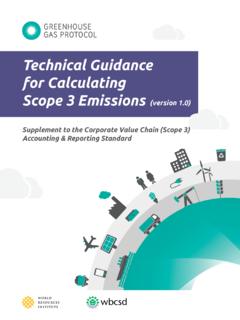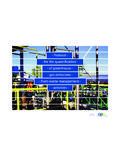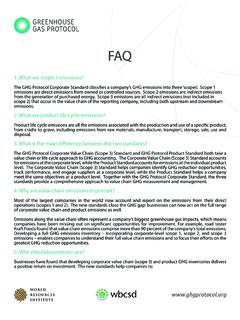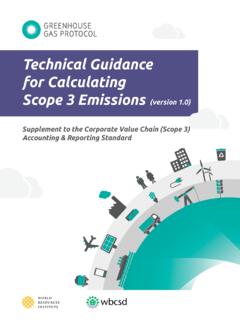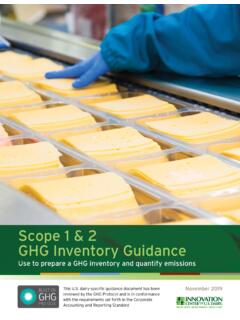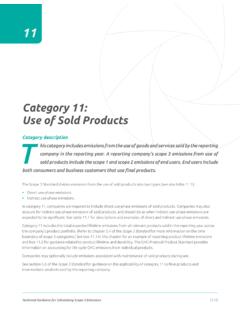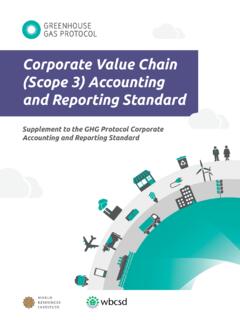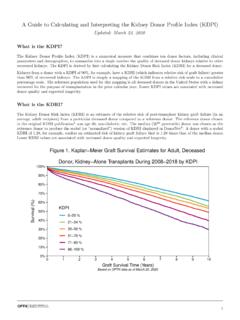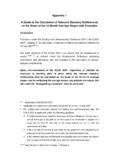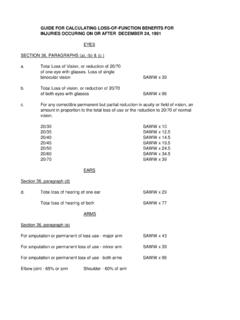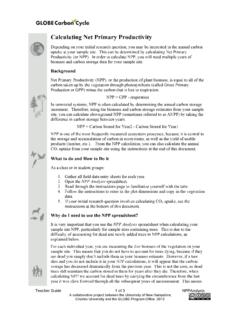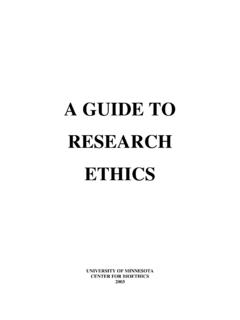Transcription of Calculating HFC and PFC Emissions from the Manufacturing ...
1 GHG Protocol HFC Tool (Version ) Calculating HFC and PFC Emissions from the Manufacturing , Installation, Operation and Disposal of Refrigeration & Air-conditioning Equipment (Version ) guide to calculation worksheets (January 2005) Table of Contents I. Overview Purpose and Domain of this Tool Process Description and Assumptions II. Choice of Activity Data and Emission Factors III. HFC Emissions from Refrigeration and Air-Conditioning Approach Description Using the Worksheets IV. Ensuring Inventory Quality V. Acknowledgements VI.
2 References1 GHG Protocol HFC Tool (Version ) I. Overview Purpose and Domain of this Section This guideline is written for plant managers and site personnel to facilitate the calculation and reporting of direct hydrofluorocarbon (HFC) Emissions resulting from Manufacturing , servicing, and disposal of refrigeration and air-conditioning equipment. Direct HFC Emissions occur from sources that are owned or controlled by the company. A step-by-step approach is presented to cover every phase of the calculation process from data gathering to reporting. This sector guideline should be applied to projects whose operations involve the manufacture, use, and disposal of refrigeration and air-conditioning equipment.
3 Process Description and Assumptions Refrigeration and air-conditioning is composed of many end-uses, including household refrigeration, domestic air conditioning and heat pumps, mobile air conditioning, chillers, retail food refrigeration, cold storage warehouses, refrigerated transport, industrial process refrigeration, and commercial unitary air conditioning systems. Historically, this sector has used various ozone-depleting substances (ODS) such as CFCs and HCFCs as refrigerants. These ODS are being phased out under the Montreal Protocol and are being replaced with HFCs.
4 HFC Emissions from the refrigeration and air conditioning sector result from the Manufacturing process, from leakage over the operational life of the equipment, and from disposal at the end of the useful life of the equipment. These gases have 100-year global warming potentials (GWP), which are 140 to 11,700 times that of carbon dioxide, so their potential impact on climate change can be significant (Table 1). By the same token, any reductions of these gases can have a large potential benefit. This protocol addresses Emissions from Manufacturing , operation, and disposal phases.
5 II. Choice of Activity Data and Emission Factors HFC Emissions can be estimated based on data readily available to manufacturers and users of refrigeration and air-conditioning equipment. This guideline contains a screening method to establish significance of HFC Emissions and two quantification approaches to quantify HFC Emissions . Reporters can choose a quantification approach based on data availability, purpose of quantification, and the level of accuracy required. The recommended approach for equipment manufacturers and for equipment users who maintain their own equipment is to estimate HFC Emissions based on the amount of refrigerant purchased and used.
6 This Sales-Based Approach requires data that should be available from entity purchase and service records, and tracks Emissions from equipment Manufacturing (producers) or installation (users), operation, servicing, and disposal. The recommended approach for equipment users who have contractors service their equipment is to track Emissions at each stage of the lifecycle of the equipment. The Lifecycle Stage Approach requires information on the quantity of refrigerant used to fill new equipment during installation, the quantity of refrigerant used to service equipment, the quantity of refrigerant recovered from retiring equipment, and the full and proper charges of new and retiring equipment.
7 If notified in advance of the need for this information, the contractor should be able to provide it. The approach tracks Emissions from equipment Manufacturing , operation, servicing, and disposal. 2 GHG Protocol HFC Tool (Version ) A screening approach is also provided if a company needs to establish whether its Emissions from RAC equipment are significant or not compared to its other emission sources. The screening approach can be applied using default equipment emission factors or leak rates. This approach should not be used as a substitute of the two quantification methods provided in this tool as it is not as accurate as the other approaches.
8 The leak rates can be highly uncertain. Using the screening approach, if a company determines that its Emissions from RAC equipment are significant, it should use one of the two quantification methods to estimate HFC Emissions . Table 1. GWPs of Common Greenhouse Gases and Refrigerants Gas or Blend GWP Source CO2* 1 IPCC Second Assessment Report (1995) CH4* 21 IPCC Second Assessment Report (1995) N2O* 310 IPCC Second Assessment Report (1995) HFC-23 11,700 IPCC Second Assessment Report (1995) HFC-32 650 IPCC Second Assessment Report (1995) HFC-125 2,800 IPCC Second Assessment Report (1995) HFC-134a 1,300 IPCC Second Assessment Report (1995) HFC-143a 3,800 IPCC Second Assessment Report (1995) HFC-152a 140 IPCC Second Assessment Report (1995) HFC-236fa 6,300 IPCC Second Assessment Report (1995)
9 R-401A 18 ASHRAE Standard 34 R-401B 15 ASHRAE Standard 34 R-401C 21 ASHRAE Standard 34 R-402A 1,680 ASHRAE Standard 34 R-402B 1,064 ASHRAE Standard 34 R-403A 1,400 ASHRAE Standard 34 R-403B 2,730 ASHRAE Standard 34 R-404A 3,260 ASHRAE Standard 34 R-406A 0 ASHRAE Standard 34 R-407A 1,770 ASHRAE Standard 34 R-407B 2,285 ASHRAE Standard 34 R-407C 1,526 ASHRAE Standard 34 R-407D 1,428 ASHRAE Standard 34 R-407E 1,363 ASHRAE Standard 34 R-408A 1,944 ASHRAE Standard 34 R-409A 0 ASHRAE Standard 34 R-409B 0 ASHRAE Standard 34 R-410A 1,725 ASHRAE Standard 34 R-410B 1,833 ASHRAE Standard 34 R-411A 15 ASHRAE Standard 34 R-411B 4 ASHRAE Standard 34 R-412A 350 ASHRAE Standard 34 R-413A 1,774 ASHRAE Standard 34 R-414A 0 ASHRAE Standard 34 R-414B 0 ASHRAE Standard 34 R-415A 25 ASHRAE Standard 34 R-415B 105 ASHRAE Standard 34 3 GHG Protocol HFC Tool (Version )
10 R-416A 767 ASHRAE Standard 34 R-417A 1,955 ASHRAE Standard 34 R-418A 4 ASHRAE Standard 34 R-419A 2,403 ASHRAE Standard 34 R-420A 1,144 ASHRAE Standard 34 R-500 37 ASHRAE Standard 34 R-501 0 ASHRAE Standard 34 R-502 0 ASHRAE Standard 34 R-503 4,692 ASHRAE Standard 34 R-504 313 ASHRAE Standard 34 R-505 0 ASHRAE Standard 34 R-506 0 ASHRAE Standard 34 R-507 or R-507A 3,300 ASHRAE Standard 34 R-508A 10,175 ASHRAE Standard 34 R-508B 10,350 ASHRAE Standard 34 R-509 or R-509A 3,920 ASHRAE Standard 34 PFC-218 (C3F8) 7,000 UNEP OzonAction Programme Chemical Database (Online) PFC-116 (C2F6) 9,200 IPCC Second Assessment Report (1995) PFC-14 (CF4) 6,500 IPCC Second Assessment Report (1995) * Included for reference purposes only.
